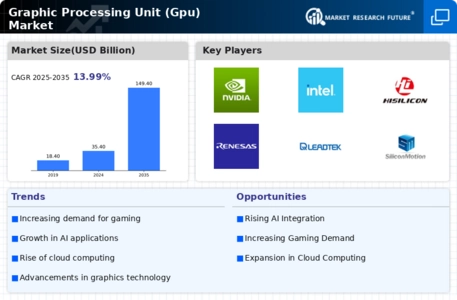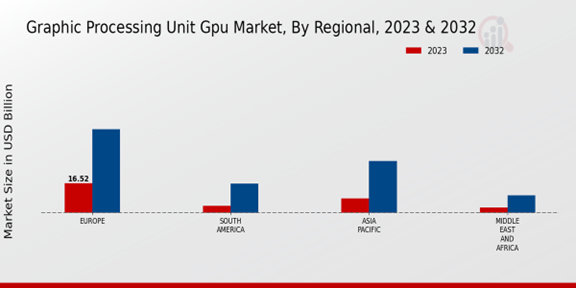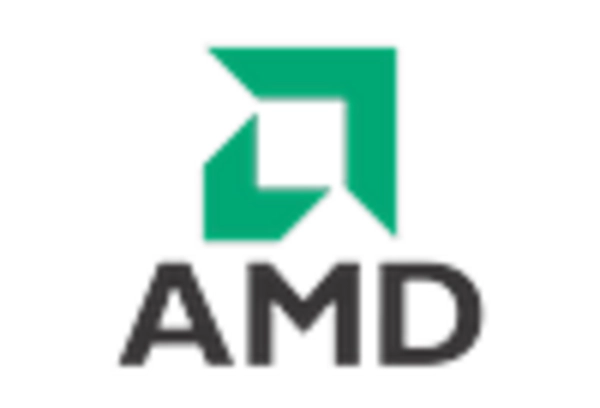Surge in Gaming Industry
The gaming industry continues to expand, driving demand for advanced Graphic Processing Units (Gpu) to enhance user experiences. As of 2025, the gaming sector is projected to reach a valuation exceeding 200 billion dollars, with a substantial portion attributed to high-performance graphics. This growth necessitates the integration of cutting-edge Gpu technology, enabling realistic graphics and immersive gameplay. The Graphic Processing Unit (Gpu) Market is thus experiencing a surge in demand, as gamers increasingly seek superior performance and visual fidelity. Furthermore, the rise of competitive gaming and eSports has intensified the need for high-end Gpus, as players require reliable and powerful hardware to gain a competitive edge. Consequently, manufacturers are compelled to innovate and produce Gpus that cater to the evolving needs of gamers, further propelling market growth.
Rise of Cryptocurrency Mining
The resurgence of interest in cryptocurrency mining has created a notable impact on the Graphic Processing Unit (Gpu) Market. As cryptocurrencies continue to gain popularity, miners require powerful Gpus to efficiently solve complex algorithms and validate transactions. In 2025, the cryptocurrency market is projected to maintain a valuation exceeding 1 trillion dollars, with a significant portion of mining operations relying on high-performance Gpus. This trend has led to increased demand for Gpus, as miners seek to optimize their operations and maximize profitability. Consequently, manufacturers are focusing on producing Gpus that cater specifically to the needs of cryptocurrency miners, further driving growth in the Graphic Processing Unit (Gpu) Market. The ongoing evolution of mining technologies and the potential for new cryptocurrencies may also influence future demand for Gpus.
Increased Adoption of Cloud Computing
The growing adoption of cloud computing services is reshaping the landscape of the Graphic Processing Unit (Gpu) Market. As businesses increasingly migrate to cloud-based solutions, the demand for Gpus that can support virtualized environments and high-performance computing is on the rise. In 2025, the cloud computing market is expected to exceed 800 billion dollars, with a significant portion of this growth driven by the need for advanced Gpu capabilities. Cloud service providers are investing in Gpu technology to offer enhanced services, such as GPU-as-a-Service, which allows users to access powerful Gpu resources without the need for substantial upfront investments. This trend indicates a shift in how Gpus are utilized, as the Graphic Processing Unit (Gpu) Market adapts to meet the evolving needs of businesses seeking scalable and efficient computing solutions.
Advancements in AI and Machine Learning
The integration of artificial intelligence (AI) and machine learning technologies is reshaping various sectors, including the Graphic Processing Unit (Gpu) Market. Gpus are increasingly utilized for AI computations due to their parallel processing capabilities, which significantly enhance performance in data-intensive tasks. As organizations adopt AI solutions, the demand for Gpus that can efficiently handle these workloads is expected to rise. In 2025, the AI market is anticipated to surpass 500 billion dollars, with a considerable share reliant on advanced Gpu technology. This trend indicates a robust growth trajectory for the Graphic Processing Unit (Gpu) Market, as companies seek to leverage Gpus for machine learning applications, data analysis, and real-time processing. The ongoing advancements in Gpu architecture further support this trend, enabling more efficient and powerful AI computations.
Emergence of Virtual and Augmented Reality
The proliferation of virtual reality (VR) and augmented reality (AR) technologies is significantly influencing the Graphic Processing Unit (Gpu) Market. As these immersive technologies gain traction across various applications, including gaming, education, and training, the demand for high-performance Gpus is expected to escalate. In 2025, the VR and AR market is projected to reach approximately 200 billion dollars, necessitating Gpus that can deliver exceptional graphics and low latency. This demand compels manufacturers to innovate and develop Gpus specifically designed for VR and AR applications, ensuring optimal performance and user experience. The Graphic Processing Unit (Gpu) Market is thus poised for growth, as the need for advanced graphics capabilities becomes increasingly critical in delivering immersive experiences across diverse sectors.


















Leave a Comment